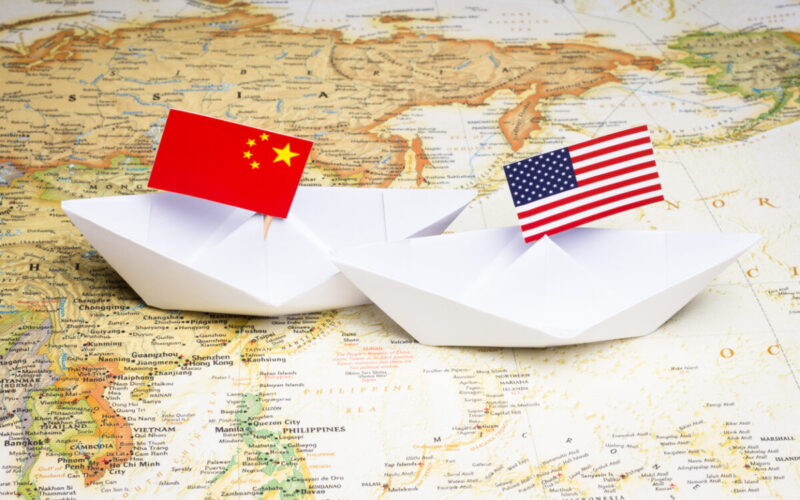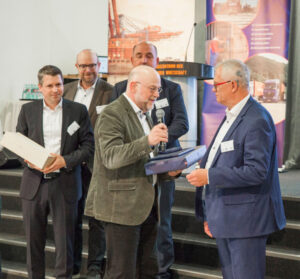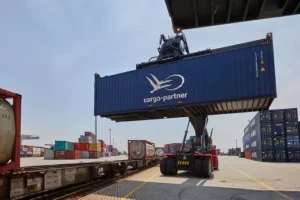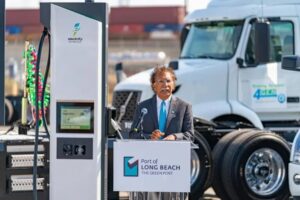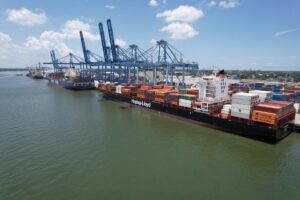Rakin Rahman, Staff Reporter at Port Technology International – PTI, sat down for an interview with Christian Sur, EVP of Ocean Freight and Contract Logistics at Unique Logistics. The discussion focused on China’s global shipping prominence and the recent shift of manufacturers to other Southeast Asian countries. Sur mentioned the factors driving this trend while highlighting infrastructural limitations in other Southeast Asian ports that hinder accommodating larger ships, thus maintaining China’s central role in global shipping.
Could you give me an oversight of what the China “plus one” strategy is and how it will impact global trade, particularly between the US and China?
CS: China’s “plus one” strategy has been in play for quite some time, predating recent disruptions like COVID-19. China has served as the world’s manufacturing hub for over two decades, particularly in the 1990s and 2000s. Certainly, many importers focusing on the US have experienced a growing dependence on China. Moreover, the cost of labour in China has seen a substantial increase over the past decade, nearly tripling compared to other countries. This trend is particularly noticeable in Southeast Asian nations such as Vietnam, Thailand, Indonesia, and the Philippines, and Southeast Asian nations in India, Cambodia, and Bangladesh.
In my over 30 years of experience in this industry, I’ve observed a shift from manufacturing in Japan, Korea, and Taiwan to China during the 1980s and 1990s. While China remains a formidable player due to its efficiency and product quality, importers have diversified their strategies due to rising labour costs. This diversification initially manifested as a “plus one” strategy, seeking alternative manufacturing locations outside China. However, recent geopolitical tensions, particularly in US-China relations, have prompted importers to consider more than one additional location.
The China “plus one” strategy existed before but is now exacerbated by increasing geopolitical tensions. However, from a business perspective, our customers primarily base their decisions on cost, with political factors being important but not the primary influence. Cost, efficiency, and product quality are the primary drivers behind the decision to shift some production away from China. This trend is expected to continue.
READ: China fires back at US interference in COSCO – HHLA CTT deal
Is the US reducing its dependency on manufacturing supplies from China? If so, how will this impact shipping logistics, including maritime routes, supply chains, and the overall global trade balance?
CS: The logistics structure, including ports, remains tied to China due to a significant portion of cargo originating there, especially from key ports like Shanghai, Yantian, Ningbo, and Xiamen.
Depending on transshipment requirements, cargo from South Asia or West Asia often passes through intermediary ports such as Singapore, Hong Kong, or Busan in Korea. However, it’s important to note that some countries in South and West Asia have limitations in terms of port size and infrastructure. This presents a challenge when accommodating larger vessels and the associated equipment required for this migration. Constructing vessels and deepening ports takes time. It’s not a situation where you build infrastructure and expect businesses to immediately follow. Instead, it’s a process where factories and manufacturing sourcing gradually moves to Southeast and West Asia. Only after that do operators, ports, and terminals begin the construction needed to accommodate this shift.
Currently, infrastructure development isn’t proceeding as quickly as desired. As migration trends continue, ports will adapt to accommodate more vessel operators. However, it’s important to note that the physical limitations of these ports in Southeast Asia and West Asia won’t allow for the handling of the larger vessels currently prevalent in the market, some of which are as large as 24,000 TEU or more. Realistically, these ports will not be equipped to handle such vessels for at least the next 5 to 10 years. As a result, China will remain the primary source of a significant portion of global cargo. This reliance on China is unlikely to change substantially in the foreseeable future, keeping the existing logistics infrastructure largely unchanged.
To address this situation, terminals and ports must expand capacity to accommodate larger vessels efficiently. This entails significant physical efforts and substantial investments, often with government backing. Local governments play a crucial role in facilitating these expansions. Unlike the swift migration of factories and products, infrastructure and port improvements are time-consuming and financially demanding, often requiring government involvement. In the development of ports and terminals, private entities rarely take the lead due to resource requirements. Thankfully, governments recognise the economic incentive of enhancing infrastructure to boost trade and increase exports. Consequently, governments are inclined to pursue this lengthy process for the long-term benefit of their economies.
Why is Vietnam becoming a vital link in the supply chain?
CS: Vietnam shares some similarities with China in terms of governance. While Vietnam’s governing party remains a communist party, they have progressively opened up to investments and improved the ease of doing business. Additionally, regarding labour quality, it’s worth noting that while I do not want to compare countries in this aspect, Vietnam stands out among other Southeast Asian nations for its efficiency. Without delving into political culture, the fact that both China and Vietnam have single-party systems means they can efficiently execute government directives.
READ: ICTSI Subic introduces new South China-Vietnam service
This was evident in China’s ability to implement swift lockdown measures when necessary. In terms of manufacturing quality, Vietnam’s standards align closely with those of China. However, it’s important to acknowledge that in some other countries, it may take longer to meet the necessary quality inspection requirements for production. Despite these variations, the shift towards moving manufacturing to places like Vietnam is gradually occurring.
With ocean markets, what are some current trends you are seeing that would be interesting to make note of?
CS: The ocean market is currently in a significant transition. In my over 30 years of experience, I have never witnessed anything quite like what occurred between the second half of 2020 through second half of 2022, covering the COVID-19 pandemic. During this period, the ocean market struggled to cope with the surge in ship traffic, especially in Asia. Additionally, there was a sudden increase in demand for goods as people stayed at home, highlighting the urgent need to address infrastructure issues. This was particularly evident in our focus on the US, where even before COVID-19, we recognised the need for infrastructure expansion to accommodate the steady growth in imports from Asia, Europe, Latin America, and other regions.
However, there are physical constraints that we must contend with. This is particularly evident in port areas, with the Port of LA and Long Beach being the largest, and ports in Seattle, Tacoma, and Oakland. In the case of West Coast ports, it’s becoming increasingly challenging to find available land for expansion, primarily due to environmental concerns. Therefore, the focus has shifted towards improving efficiency. Additionally, another significant challenge, as you may have observed this year, is labour strikes affecting both the West Coast and East Coast ports. This significantly hampers productivity when compared to ports in Asia and Europe, which have embraced automation, some as far back as 20 years ago. These factors exacerbated the situation when shipping volumes suddenly surged, overwhelming terminals, ports, railroads, and trucking operations, resulting in widespread congestion.
This is why you’ve seen ships waiting outside major ports, which limits how much they can handle. If you don’t see ships lined up outside the ports anymore, it’s because demand has slowed down. People are getting back to work, and there’s already a high inventory of goods in the US. We’re waiting for the holiday season to pass, hoping that some of these goods that have been sitting in warehouses for over a year will start to be consumed to restart major orders from Asia, and that will boost shipping volumes again. However, any sudden increase in demand, whether it’s due to a holiday season or any other reason, can lead to congestion at port terminals and on railroads.
In the US, there are primarily two railroads on the West Coast, BNSF and UP, and they prioritise domestic rail transportation over international shipping. This means they focus more on moving railcars back to the West Coast from inland areas. These dynamics haven’t changed, so whenever there’s a surge in market volume as we continue to grow and consumers start buying more, we encounter these issues again. Regarding labour, while the ILWU issue has largely been resolved, the ILA is currently negotiating for the East Coast. Fortunately, East Coast ports have an advantage in terms of available land for expansion because they are not located in densely populated downtown areas like LA.
One concern we’re addressing is draft restrictions in the Panama Canal. However, this isn’t a significant issue for container vessels. They operate on fixed schedules, booking canal transits well in advance for punctual passage. Other vessel types have irregular schedules, potentially leading to wait times. Summer rains affecting lake levels could cause minor delays, primarily for dry bulk, not container shipping. Some cruise services have stopped to avoid passenger wait times. Aside from infrastructure and labour issues, climate, and environmental concerns, including IMO emissions requirements, may limit vessel capacity. Many top clients prioritise eco-friendly services, making these considerations enduring challenges.
What do you see for the future of the shipping and logistics industry?
CS: We’re looking ahead at how sourcing patterns will keep evolving. I mentioned countries in Southeast Asia like Vietnam, Thailand, and Indonesia, but India is expected to see significant growth. As our industry explores sourcing from different countries and regions, such as the Middle East to Europe, diversity will increase. So, the reliance on not just China but all of Asia for sourcing and buying products will continue to shift. This diversification is a response to the realisation during the COVID-19 pandemic that heavy reliance on single or couple sourcing options in Asia could lead to congestion issues. Companies started thinking about alternatives like Mexico or Europe, but often lacked the infrastructure to meet the demand in those places. Many of our clients are considering these factors, and we’re positioning ourselves to expand into these areas, reducing dependence on China and Southeast Asia. These changes will be ongoing in our industry.
When it comes to ships, they’re getting larger, smarter, and more eco-friendly, however, this growth in size limits where they can dock. These massive 24,000 TEU vessels can only visit European and Chinese ports, and eventually the LA and Long Beach ports. They can’t fit into East Coast ports or even Seattle Tacoma because they’re just too big, and they’re going to keep getting even bigger. Operators prefer larger ships for cost savings, meeting environmental rules, and reducing port fees through fewer visits. We should explore opportunities in smaller shipping lanes within Asia, Europe, and the US while focusing on supporting larger routes that accommodate these increasingly massive vessels.
This requires both short-term and long-term planning and adaptability. When I first started in this industry in the early 90s, the largest vessels were around 4,000 TEU. As ships keep getting bigger, especially in the US where adjustments tend to be slower, challenges persist. These challenges affect the supply chain, making it difficult for people to transport products from one place to another, especially when importing or exporting. This is an issue that continues to concern many, and it’s the kind of discussion I engage in with our clients. They want to understand what’s happening in the near future and the long term.

Christian Sur is the Executive Vice President at Unique Logistics International, responsible for overseeing the company’s ocean freight and contract logistics products. Prior to joining Unique Logistics, Christian served in senior commercial and marketing positions at major steamship lines such as Hanjin Shipping/SM Lines since 1991. His focus was on organisational management and business development for key clients like Walmart, Target Stores, Nike, HP, Amazon, Microsoft, Starbucks, Costco, Samsung, LG, and Electrolux.

